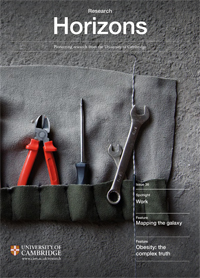
Almost half of young people in the UK now go to university. Who gets in – and what and where they study – affects a person’s place in society and their future earnings, as well as the skills available to the job market. Can big data help the ‘fifty percenters’ make one of the most important decisions of their lives – and advance the success of the UK’s graduate economy?
Almost half of young people in the UK now go to university. Who gets in – and what and where they study – affects a person’s place in society and their future earnings, as well as the skills available to the job market. Can big data help the ‘fifty percenters’ make one of the most important decisions of their lives – and advance the success of the UK’s graduate economy?
We might argue the government should be investing more in education across the piece because we want a highly skilled future, but some hard choices need to be made about where to invest. That’s where big data approaches can inform a wider debate
Anna Vignoles
At the start of the 1970s there were 600,000 university students. Now there are 2.5 million. In 2017, the participation of young people in higher education reached 49% – the highest level since the introduction of tuition fees.
University offers the promise of life-changing opportunities and teaching that develops knowledge and skills. Individuals, society and the economy are all winners in the game of higher education.
On the other hand, students will face an average debt of £50,000, a rising drop-out rate in some institutions and an uncertain future job market.
Arguably it is the best of times and the worst of times to be a student.
And now experts are predicting that 300,000 new university places will be needed by 2030 to keep up with demand.
“Needed is an interesting word in this context,” reflects Professor Anna Vignoles from Cambridge’s Faculty of Education. “It indicates an assumption that is built into our society that everybody should try to go to university. If this is the case then it becomes absolutely vital that prospective students understand what this means in terms of their future employability.”
Education plus the jobs it leads to are major factors in improving social mobility and the growth of an economy. And while Vignoles doesn’t claim to have answers to how this works best, what she and her colleagues do have is access to the largest UK education dataset ever to link education with earnings – and a set of complex questions to ask of it.
The data has been collected as part of the Department of Education’s Longitudinal Education Outcomes (LEO). It’s actually two datasets: the educational performance of three million primary-school-aged children per year, followed through their secondary and further education to university, including the subject and university they choose; and their subsequent tax records data up to ten years after graduating.
 Vignoles and colleagues in Cambridge and the Institute of Fiscal Studies are the first to be given access to such types of data, which they’ve been working on since 2013. Some of their results have been published, and many more are to follow.
Vignoles and colleagues in Cambridge and the Institute of Fiscal Studies are the first to be given access to such types of data, which they’ve been working on since 2013. Some of their results have been published, and many more are to follow.
“The top-line result is that graduate-level skill is valued in the labour market and that, for most graduates, higher education leads to much better earnings than those earned by non-graduates,” says Vignoles. “Tony Blair pledged in 2001 as Prime Minister to increase the proportion of young people progressing to university to 50%. It’s clear that the UK is now well on its way to this milestone and to achieving the ambition of becoming a graduate economy.”
But when the team looked in detail at how graduate earnings vary by institution, degree subject and parental income, they were struck by the sheer scale of the variation.
For instance, their initial study, published in 2016, showed that more than 10% of male graduates from the London School of Economics, Oxford and Cambridge were earning in excess of £100,000 a year ten years after graduation, whereas the median earnings of graduates from some institutions were less than the median earnings of non-graduates ten years on.
Medical students were the highest earners ten years after graduating, followed by economics graduates. Those studying the creative arts had the lowest earnings, but there were major differences depending on the institution attended.
Some of these earnings differences are attributable to differences in entry requirements and levels of prior achievement at A-level. The point that Vignoles makes is that it’s important for young people to be aware of these differences when they make their choices.
“Of course factors beyond graduate earnings, such as the student’s interest in a subject, will and should drive student choice, and we should value subjects irrespective of whether they have high earnings,” says Vignoles. “However, it is also important that we don’t hide this information from students in the hope that they won’t notice the lack of jobs or earning power when they leave.”
The team’s analysis of LEO doesn’t just give a full picture of what our education system is doing as a whole but also what it’s doing for those from disadvantaged backgrounds.
“It’s partly through analysis of these data that we show that a massive socio-economic gap in achievement at the point of entry into the school system actually worsens through primary and early secondary school. It is these early gaps in achievement that are largely responsible for fewer young people from poorer households going to university.”
But the inequality doesn’t end there. “What you really want to know is what about the students from poorer backgrounds who have managed to achieve in the system? We shouldn’t expect any difference between their success in the labour market and that of their advantaged peers – if education is the route to social mobility then they’ve done their bit.”
In fact they found that students from richer backgrounds still did better in the labour market than other students. “Even students who studied the same subject at the same university earn on average 10% less than more affluent peers if they come from poorer backgrounds,” she says.
“Why is there this second socio-economic gap? Is it around ‘social capital’ networks that they don’t have? Or types of postgraduate study they can’t afford? It’s really important for us to know what we’re dealing with so that we can get to the root causes.”
The team’s findings are also relevant to discussions around the demand for skills that will advance the success of the UK’s economy and the level at which the state subsidises higher education. “How these relate to higher education are controversial issues,” says Vignoles, “It’s important that the intrinsic value of going to university is not lost in discussions that focus on the economics of human capital investment.”
Yet, according to the 2017 CBI/Pearson Education and Skills Survey, 61% of businesses said that they fear a shortage of people with the necessary skills to fill their predicted increase in high-skilled roles over the coming years.
Meanwhile, the government underwrites student loans; graduates pay 9% of their earnings above an income threshold of £25,000. “For around three quarters of graduates, it’s unlikely they will have paid off the loan by the end of their working lives,” says Vignoles.
“This income contingency is crucially important – we can’t give students mortgage-sized debts and ask them to take the risk of not being able to repay them. The state has to subsidise students. But, as a consequence, the state will be subsidising some subjects that attract lower earnings more than others. And subsidy for higher education may mean less resource for further education or apprenticeships. We need a public debate on this.
“We might argue the government should be investing more in education across the piece because we want a highly skilled future, but some hard choices need to be made about where to invest. That’s where big data approaches can inform a wider debate – helping us to dig deep below the surface of these complex issues.”
Inset image: read more about our research on the topic of work in the University's research magazine; download a pdf; view on Issuu.

The text in this work is licensed under a Creative Commons Attribution 4.0 International License. Images, including our videos, are Copyright ©University of Cambridge and licensors/contributors as identified. All rights reserved. We make our image and video content available in a number of ways – as here, on our main website under its Terms and conditions, and on a range of channels including social media that permit your use and sharing of our content under their respective Terms.




